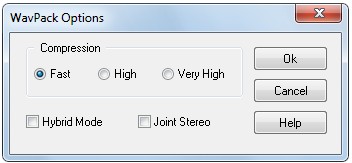Features
WavPack compression (.WV files) can compress (and restore) 8-, 16-, 24-, and 32-bit fixed-point, and 32-bit floating point audio files in the .WAV file format. It also supports surround sound streams and high frequency sampling rates. Like other lossless compression schemes, the data reduction rate varies with the source, but it is generally between 30% and 70% for typical popular music and somewhat better than that for classical music and other sources with greater dynamic range.

Hybrid mode
WavPack also incorporates a "hybrid" mode which still provides the features of lossless compression, but it creates two files: a relatively small, high-quality, lossy file (.wv) that can be used by itself; and a "correction" file (.wvc) that, when combined with the lossy file, provides full lossless restoration. This allows the use of lossy and lossless codecs together.
The default operation of WavPack is pure lossless, which means that the .wv file contains all the information that was in the original .wav file. The hybrid mode allows the user to specify a target bitrate for the output file, either in kilobits per second (kbps) or bits per sample. If the track can be losslessly compressed without exceeding the specified bitrate, then it will be and WavPack will report the compression as lossless. If lossless compression would exceed the specified bitrate, then WavPack will begin carefully discarding the least significant portion of the audio information to stay within the limit. Every effort is made to keep this inaudible, including the use of joint stereo, dynamic bit allocation and noise shaping. WavPack will report this as "lossy" compression. Although the option accepts bitrates as low as 24 kbps, the actual value that WavPack can achieve is usually much higher than that. For example, with CD-audio sampled at 44.1k the lower limit is about 196 kbps.
Compession
Fast Mode
The "fast" mode should be used when compression (or decompression) speed is more important than compression ratio (or, in lossy mode, audio quality).
High quality (better compression in all modes, but slower)
The "high" mode should be used when compression ratio (or, in lossy mode, audio quality) is more important than compression (or decompression) speed. This option slows both by about a factor of about 1.5.
Very high quality (best compression in all modes, but slowest)
The "very high" mode should be used when compression ratio (or, in lossy mode, audio quality) is much more important than compression (or decompression) speed. This option slows both by about a factor of about 2, and is not recommended for use on portable devices because of the high CPU load required for decoding.
Joint Stereo
WavPack normally defaults to joint stereo (sometimes called mid/side) in which the left and right channels are combined to form an alternate representation (essentially L+R and L-R) that compresses better in lossless mode and improves quality in lossy mode. This option allows this feature to be forced either on or off.
|
Copyright (c) 2013 AudioDope team. All rights reserved.
|
|
What do you think about this topic? Send feedback!
|